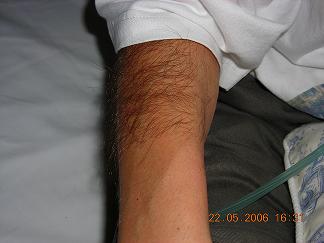A Hirsute Man With Sallow Appearance
Stem:
This gentleman has lethargy of 6/12 duration. Please examine his abdomen.

 Record:
Record:I would complete my examination on this gentleman by checking his blood pressure, looking at his temperature chart and dipstick the urine to look for evidence of haematuria and proteinuria. I would also like to do a per rectal examination to exclude malaena as a possible cause for his pallor.
This gentleman is lying comfortable on one pillow. He is on supplemental O2 administered via nasal prong running at 2L/min. He has a sallow complexion. There is no peripheral stigmata of chronic liver disease. He has no flapping tremour. He has hirsutism as evidenced by coarse hairs over both of his arms as well as on the face. He looks pale however there is no jaundice. There is gum hypertrophy.
On inspection of the abdomen, there is a transverse surgical scar noted at the right lumbar region extending to the infraumbilical region which is well healed. The umbilicus is centrally located and inverted. Palpation of the abdomen has revealed a mass situated at the right iliac fossa which measures around 5x8cm in size, is firm in consistency, non-tender and it produces a dull note upon percussion. There is no other mass felt in the abdomen. There is no ascites and the bowel sounds are normal. There is no signs of fluid overload.
Therefore, I would like to draw conclusion that this gentleman has a right transplanted kidney complicated by signs suggestive of cyclosporin side effects, currently no signs of fluid overload and not in uraemic encephalopathy. The possible etiologies for his renal failure I would like to offer include diabetic nephropathy, hypertensive nephropathy and other primary glomerulonephritis.
Labels: Abdomen








2 Comments:
why the patient was on oxygen?
Thanks surrayya for your comment. Your observation is sharp. This patient, as my failing memory could recall, was admitted for a suspected commnity acquired pneumonia complicating immunosuppression therapy. He was discharged well after a complete course of antibiotics.
Post a Comment
<< Home